Signalised intersections have many similar design considerations to midblock pedestrian signals.

Raised intersection with a scramble crossing (Barnes dance), Colombo St/Lichfield St, Christchurch (Photo: Gemma Dioni)
The main advantage of signalised intersections is the spatial and temporal separation of people walking from people driving. Additional benefits of signalised intersections, as well as their implications and parameters are outlined below.
Pedestrian displays including how the green and red pedestrian signal aspects and countdown pedestrian signals should be installed and operated are outlined in the TCD Rule, Section 6.6.
Additional traffic signs permitted on a pole supporting a traffic signal are outlined in Section 10.5(2).
Land Transport Rule: Traffic Control Devices 2004
Pedestrians, riders of mobility devices, and riders of wheeled recreational devices who are using the footpath must not enter the roadway when the flashing or steady red standing human figure is showing and may enter the roadway when the green walking human figure is showing (Road User Rule, 3.5).
Pedestrians must not cross any other part of a roadway that is within 20m of the part controlled by traffic signals (Road User Rule, 11.3(2)).
Land Transport (Road User) Rule 2004
The design of a signalised intersection should reflect the desired use of the street and the people movements on the street. It will generally look and operate differently depending on location and the number of people using the signals due to the context. Check the intersection design principles guidance and signalised crossings guidance for further information. In particular, establish the design vehicle early in the design process so the scale of the intersection can be determined.
PNG: Intersection design principles
The following aspects should be considered at signalised intersections to cater for safer and convenient movement of pedestrians:
PNG: General design requirements
Individual kerb ramps should be provided for each pedestrian crossing movement that is catered for at the intersection. The location of the kerb ramps is influenced by the corner radii and other constraints. Satisfactory kerb ramp layouts can usually be devised with corner radii of 3m or less as outlined in RTS14.
RTS14 - Guidelines for facilities for blind and vision impaired pedestrians [PDF, 1.6 MB]
The table below outlines the options for installing kerb ramps at signalised intersections with the preferred option being a perpendicular arrangement. Note, the requirement for and placement of directional tactile indicators depends on the location of the kerb crossing in relation to the continuous accessible path of travel and the footpath width. Refer to RTS14 for further guidance.
Table: Kerb ramp installation at intersections
Perpendicular
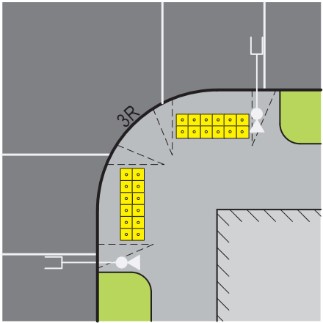
Perpendicular kerb ramp
Design issues:
Preferred arrangement.
Diagonal
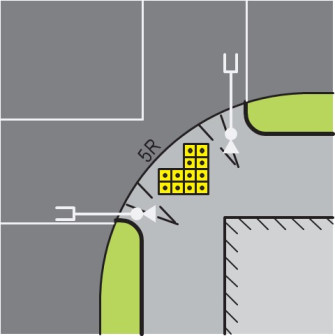
Diagonal kerb ramp
Design issues:
Acceptable in retrofit situations: prefer perpendicular instead.
Wide radii
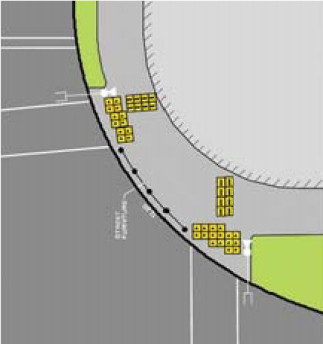
Wide radii kerb ramp
Design issues:
Not preferred: where crosswalks cannot be set back diagonal may be better.
Pedestrians are assisted at signalised intersections by either an automatic pedestrian phase or they are required to push the button to request a phase to cross. In high pedestrian areas and co-ordinated networks, having automated pedestrian phases provides balance between the demands of people wanting to cross the road and people travelling through the intersection by other modes including people on bikes and buses. In some contexts it may be appropriate for two phases per cycle to be allocated to pedestrians crossing which provides a higher level of service.
Where pedestrian volumes are light, user demanded pedestrian phases may be acceptable and may provide more efficiency for mixed vehicles and cycles.
Non-compliance of traffic signals will increase with the amount of time pedestrians are delayed and may lead to risky behaviour by pedestrians. NZ research[1] found that the threshold is about 20-30 seconds of delay.
Long signal cycles, compounded over multiple intersections, can make crossing a street or walking even a short distance prohibitive and frustrating. This reduces walkability of a street or area.[2]
In general, shorter signal cycles (up to 90 seconds) are preferred for vehicles as they provide predictable and regular crossings, and generally minimise overall delay for drivers. While short cycles tend to encourage people to obey the signals compared with locations with longer delays, the short cycle length needs to be weighed against the safety benefits of separated signal phases, such as having dedicated right-turn signals.
The crossing time should be long enough for pedestrians of all ages and abilities to cross wide streets in a single leg without having to stop in the median, unless the median is a destination in and of itself.
Multistage crossings are often used within intersections to allow pedestrians to cross with certain vehicle movements and therefore should be avoided in places of high pedestrian volumes or where less confident or less able pedestrians are expected. They are generally a product of providing for maximum vehicle capacity rather than pedestrian convenience. To cross a single leg or to get to the opposite corner, several crossing stages must be negotiated. Waiting areas for pedestrians should be large enough to accommodate the expected numbers of pedestrians, particularly people using wheelchairs or pushchairs who need space to turn. The most important concept for the phasing of staged pedestrian crossings is that the two halves of a crossing can be operated independently [3]. Thus, when the approach leg of the crossing is in operation the approach vehicles will be stopped but vehicles entering the departure leg may be allowed and vice-versa as shown in the phasing diagrams below. The phasing should be co-ordinated according to the direction of the crossing demand to minimise the waiting time in the central median.
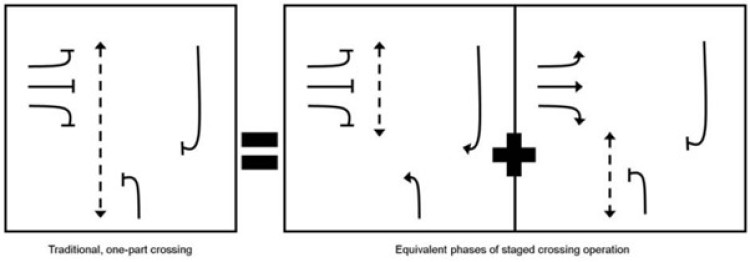
Phase components of traditional and staged signalised intersections (Source: Fowler and Wilke, 2008)
The following operational considerations are important for accommodating pedestrians safely and efficiently at signalised intersections:
For more details on countdown pedestrian signals refer to the Traffic Control Devices Rule Clause 6.6.
In a signal co-ordinated street, signal timing should be to or below the speed that vehicles are intended to travel along the street to reduce speeding, particularly on one-way streets. Lower speeds improve the overall amenity for people walking along a street but also reduce the severity of any crashes with pedestrians in line with a safe system approach. Lower speeds also increase the attractiveness and comfort of pedestrians waiting at the corners and in central islands.
While separating vehicle movements through signal phasing may have safety benefits, additional phases increase wait times for everyone including pedestrians by increasing the overall length of the signal cycle. Consider turn restrictions at complex intersections or, where turn volumes necessitate a dedicated turn phase, introduce a protected right-turn phase[4]. If the intersection is in a high pedestrian demand area, it may be that conflicting movements are restricted to reduce the likelihood of a collision but to also ensure pedestrians receive a high level of service. This is likely to be appropriate on City Hubs and the ends of Civic Spaces.
There are two types of phasing for people crossing the road as outlined in the table below. Exclusive pedestrian phases mean pedestrians can cross when there are no conflicting movements. Conversely a concurrent phase allows people to cross while parallel and non-conflicting vehicles are also moving. The table below identifies design considerations for pedestrians and other road users for the different phasing types. The conflicts and their likely severity between people cycling, pedestrians and turning vehicles and especially heavy vehicles should be assessed with design and phasing options considered that minimise the risks [5].
Table: Signal phasing options
|
Phasing |
Description |
Design considerations for people crossing |
Design considerations for other road users |
|
Exclusive |
|||
|
Exclusive (scramble/ Barnes dance) |
All vehicles stop and pedestrians can cross in any direction. |
Beneficial where there are high pedestrian numbers. Need to allow sufficient footpath space to hold waiting pedestrians. Pedestrians will likely have priority over other transport modes. Automatically call the pedestrian phase. This can have double phases, so pedestrians receive two phases per cycle. Beneficial where high numbers of less able or less confident pedestrians are crossing (children, mobility impaired or older users). Kerb ramps need to be wider than at a standard intersection to cater for the various movements across the intersection. May not be appropriate at extremely wide intersections where a diagonal crossing may take a significant time to complete. Need to ensure signal heads are visible for people crossing diagonally. Safer for pedestrians than concurrent phasing. |
Greater delay to vehicles due to longer pedestrian phase. Ensure approaching drivers can’t see the countdown timer displays or pedestrian aspects as they may mistake these for their own signals. |
|
Concurrent |
|||
|
Fully controlled (exclusive) right and left turn arrows |
Turning vehicles are held on a red arrow to give pedestrians protection when crossing the road from turning vehicles. |
Gives priority to pedestrians over turning vehicles. Safer for pedestrians over a partially controlled turn or parallel turn. Beneficial where high numbers of vulnerable pedestrians are crossing (children, mobility impaired or older users). |
Consider whether turning lanes or bays are needed. There is less delay for through vehicle movements. |
|
Partially controlled right and left turns ‘red arrow drops off’/Leading pedestrian intervals (early start) |
Turning vehicles are held on a red arrow whilst pedestrians start to cross then the red arrow drops out and vehicles turn but yield to pedestrians. |
Provides a minor safety benefit to pedestrians as they are more visible to drivers once they are on the crosswalk. Pedestrian safety relies on driver compliance and is more suited to low speed environments. Pedestrians (in particular those less able or less confident) may feel intimidated by turning vehicles. |
Conflict remains between turning vehicles and pedestrians, albeit delayed (more likely to occur later in the phase) |
|
Parallel |
Vehicles yield the right of way to pedestrians crossing the road into which they are turning. |
Pedestrian safety relies on drivers yielding to pedestrians. Pedestrians may feel unsafe or pressured to cross quickly if vehicles are waiting to turn. |
Pedestrians and parallel drivers set off at the same time, and this can lead to conflict with turning vehicles. There is less delay to vehicles. Parallel phasing is not suitable where there are a high number of pedestrians or a high number of vehicles. Heavy vehicles have blind spots on their left side when turning drivers are unable to see pedestrians crossing from alongside. |
|
Prohibiting turns |
Turning movements are prohibited to eliminate conflict with people crossing the road. |
Would need to relocate the turn or promote an alternative route. Removes conflict between pedestrians and turning vehicles. |
|
In any signal phasing arrangement, the other important factor for safety is drivers being in the ‘dilemma zone’. This is the area on the approach to the signals where the driver does not know whether they can stop safely or not for the changing signals. The reaction of drivers in the ‘dilemma zone’ varies with their perception of the risk. This typically results in rear end crashes at signals. However, there is a high risk of a serious injury crash with a pedestrian if a driver crosses the end of the ‘dilemma zone’ and a pedestrian has received the green signal to cross on the far side of the intersection. The designer can reduce this by:
Note: Intergreen is the time between the end of a green period of one phase and the beginning of a green period of the next phase.
Signal phasing is complex and it is recommended a specialist signals engineer is employed to identify appropriate phasing arrangements.
Designers should also refer to signalised crossings for other design information including signal display types.
Typical layouts for signalised intersections are provided in Section 6.8 of the TCD Manual Part 4.
TCD Manual Part 4 (draft for consultation) [PDF, 35 MB]
Specific treatments that can assist pedestrians to cross at signalised intersections are outlined in the sections below. The combination of infrastructure depends on the context of the intersection.
Kerb ramps must be provided to direct pedestrians to each crosswalk. Ensure there is a minimum 1m width of full height kerb between kerb ramps to avoid a tripping hazard as outlined in RTS14. Appropriate tactile indicators must also be provided and located appropriately.
PNG: Designing for blind and low vision people
Crosswalk markings guide the movement of pedestrians across signalised intersections. Pedestrian crosswalk widths should accommodate the pedestrian volumes using the crossing. The TCD Manual Part 4 outlines minimum crosswalk dimensions and their location including diagonal crosswalk lines at Barnes dance control.
Other signs and marking requirements for signalised intersections are provided in the TCD Manual Part 4 Section 6.4, 6.5 and 6.6.
TCD Manual Part 4 (draft for consultation)
Kerb extensions can minimise the crossing distance for pedestrians. The shape of the kerb extensions will depend on the size of turning vehicles using the intersection. Ideally the kerb ramps should be placed on straight sections of the kerb extension for ease of applying tactile indicators that are legible.
Pedestrian refuges or median refuges allow pedestrians to cross a wider intersection in two stages. This allows for different phasing arrangements as discussed in the Signal phasing section above.
It is important to provide sufficient space in the median for pedestrians including those using mobility devices, wheelchairs and prams, to wait and to pass others walking in the opposite direction.

Wide median island provides comfortable space for pedestrians including groups and those using mobility devices and prams (Photo: Gemma Dioni)
Pedestrian platforms and raised intersections can be used to improve safety through signalised intersections by encouraging safer vehicle speeds. An example of a raised intersection is shown in the photo below.
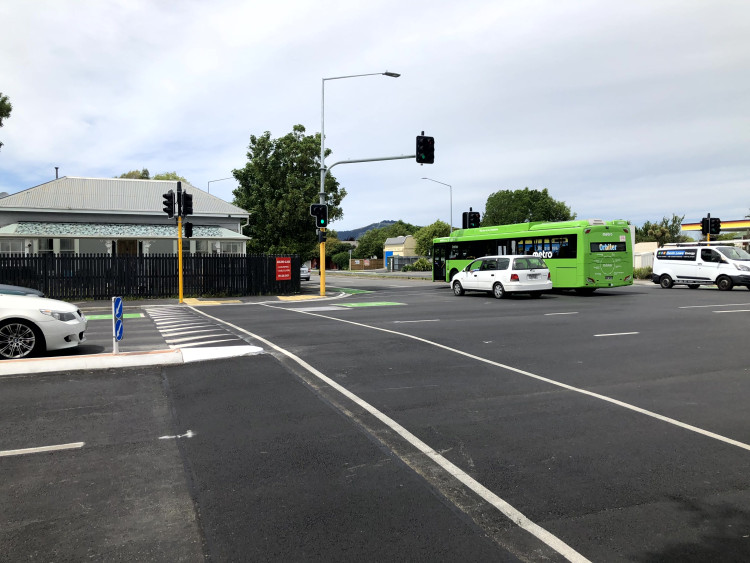
Raised signalised intersection, Lincoln Avenue/Whiteleigh Avenue, Christchurch (photo: Ann-Marie Head)
Refer to the vertical deflection devices section in terms of benefits and implications for pedestrians.
PNG: Vertical deflection devices
A typical layout of a raised signalised intersection is shown below.
Typical layout of raised signalised intersection (Source: Jeanette Ward)
[1] Vallyon, S. and Turner, S. (2011). Reducing pedestrian delay at traffic signals. NZ Transport Agency research report 440.
[2] NACTO (undated). Urban Street Design Guide – Signal Cycle Lengths(external link)
[3] Fowler and Wilke (2008). Staged Pedestrian Crossings(external link)
[4] NACTO (undated) .Urban Street Design Guide - Signalization Principles(external link)
[5] VicRoads (2016). Guidance on Treating Pedestrian and Turning Vehicle Conflicts at Signalised Intersections(external link), Traffic Engineering Manual Volume 3 – Additional Network Standards and Guidelines